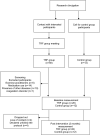Effects of time-restricted feeding in weight loss, metabolic syndrome and cardiovascular risk in obese women
- PMID: 33407612
- PMCID: PMC7786967
- DOI: 10.1186/s12967-020-02687-0
Effects of time-restricted feeding in weight loss, metabolic syndrome and cardiovascular risk in obese women
Abstract
Background: The increasing prevalence of overweight and obesity among the worldwide population has been associated with a range of adverse health consequences such as Type 2 diabetes and cardiovascular diseases. The metabolic syndrome (MetS) is a cluster of cardiometabolic abnormalities that occur more commonly in overweight individuals. Time-restricted feeding (TRF) is a dietary approach used for weight loss and overall health. TRF may be an option for those subjects who struggle with extreme restriction diets with foods that generally do not belong to an individual's habits.
Objective: The purpose of this study was to determine the effect of TRF on body composition and the association of weight loss with metabolic and cardiovascular risks in obese middle-aged women.
Methods: A non-randomized controlled clinical trial was performed over 3 months in obese women (TRF group, n = 20, BMI 32.53 ± 1.13 vs. Control n = 12, BMI 34.55 ± 1.20). The TRF protocol adopted was 16 h without any energy intake followed by 8 h of normal food intake.
Main outcomes and measures: Anthropometric measurements, body composition, blood biomarkers, cardiovascular risk in 30 years (CVDRisk30y), and quality of life were evaluated at baseline and after the 3 months.
Results: TRF was effective in reducing weight (~ 4 kg), BMI, % of body fat (%BF), waist circumference from baseline without changes in blood biomarkers associated with MetS. TRF promoted a reduction in CVDRisk30y (12%) wich was moderately correlated with %BF (r = 0.62, n = 64, p < 0.001) and %MM (r = - 0.74, n = 64, p < 0.001).
Conclusions: TRF protocol reduces body weight without changes in biomarkers related to MetS. In addition, the anthropometric evaluation that predicts %BF and %MM could be used as an approach to follow individuals engaged in the TRF regimen since they correlate with cardiovascular risk.
Keywords: Anthropometry; Cardiovascular risk; Intermittent fasting; Metabolic syndrome; Obesity; Time-restricted feeding; Weight loss.
Conflict of interest statement
The authors declare that they have no competing interests.
Figures




References
-
- Dixon JB, Browne JL, Mosely KG, Rice TL, Jones KM, Pouwer F, et al. Severe obesity and diabetes self-care attitudes, behaviours and burden: implications for weight management from a matched case-controlled study. Results from Diabetes MILES–Australia. Diabet Med. 2014;31:232–240. doi: 10.1111/dme.12306. - DOI - PubMed
-
- Poirier P, Giles TD, Bray GA, Hong Y, Stern JS, Pi-Sunyer FX, et al. Obesity and cardiovascular disease: pathophysiology, evaluation, and effect of weight loss: an update of the 1997 American Heart Association Scientific Statement on Obesity and Heart Disease from the Obesity Committee of the Council on Nutrition, Physical Activity, and Metabolism. Circulation. 2006;113:898–918. doi: 10.1161/CIRCULATIONAHA.106.171016. - DOI - PubMed
-
- Alberti KGMM, Eckel RH, Grundy SM, Zimmet PZ, Cleeman JI, Donato KA, et al. Harmonizing the metabolic syndrome: a joint interim statement of the International Diabetes Federation Task Force on Epidemiology and Prevention; National Heart, Lung, and Blood Institute; American Heart Association; World Heart Federation; International Atherosclerosis Society; and International Association for the Study of Obesity. Circulation. 2009;120:1640–1645. doi: 10.1161/CIRCULATIONAHA.109.192644. - DOI - PubMed
Publication types
MeSH terms
Grants and funding
LinkOut - more resources
Full Text Sources
Other Literature Sources
Medical
Miscellaneous

